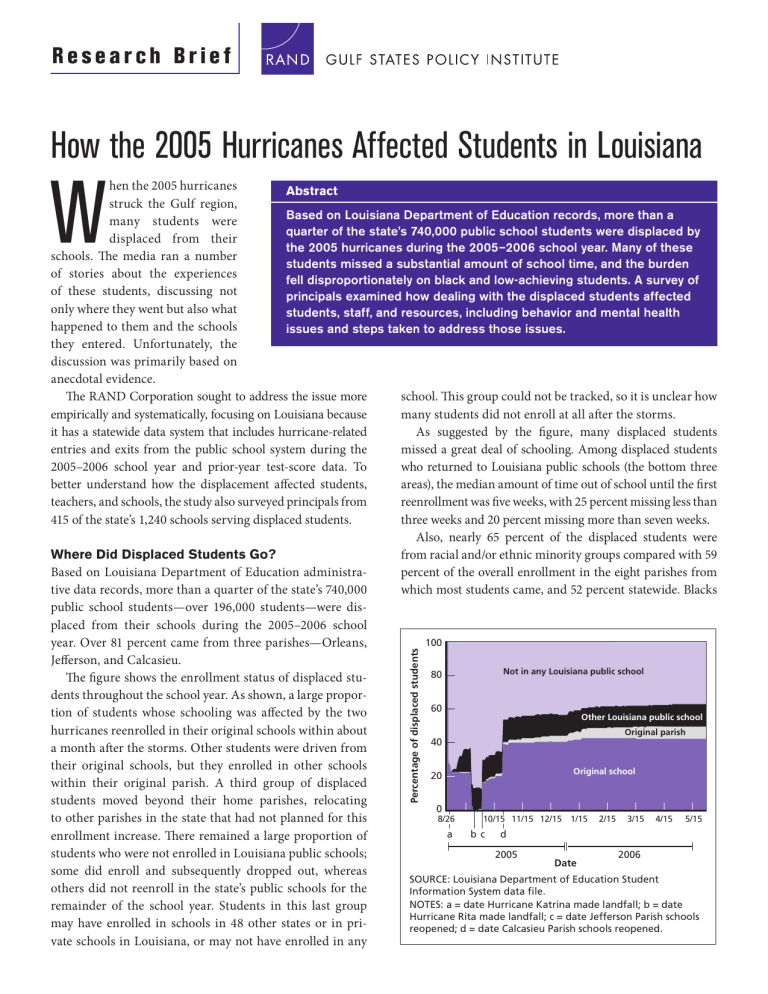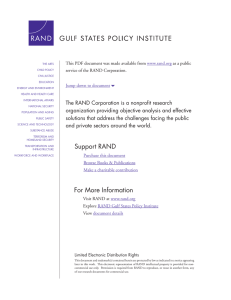W How the 2005 Hurricanes Affected Students in Louisiana
advertisement

Research Brief How the 2005 Hurricanes Affected Students in Louisiana hen the 2005 hurricanes Abstract struck the Gulf region, Based on Louisiana Department of Education records, more than a many students were quarter of the state’s 740,000 public school students were displaced by displaced from their the 2005 hurricanes during the 2005–2006 school year. Many of these schools. The media ran a number students missed a substantial amount of school time, and the burden of stories about the experiences fell disproportionately on black and low-achieving students. A survey of of these students, discussing not principals examined how dealing with the displaced students affected only where they went but also what students, staff, and resources, including behavior and mental health happened to them and the schools issues and steps taken to address those issues. they entered. Unfortunately, the discussion was primarily based on anecdotal evidence. school. This group could not be tracked, so it is unclear how The RAND Corporation sought to address the issue more many students did not enroll at all after the storms. empirically and systematically, focusing on Louisiana because As suggested by the figure, many displaced students it has a statewide data system that includes hurricane-related missed a great deal of schooling. Among displaced students entries and exits from the public school system during the who returned to Louisiana public schools (the bottom three 2005–2006 school year and prior-year test-score data. To areas), the median amount of time out of school until the first better understand how the displacement affected students, reenrollment was five weeks, with 25 percent missing less than teachers, and schools, the study also surveyed principals from three weeks and 20 percent missing more than seven weeks. 415 of the state’s 1,240 schools serving displaced students. Also, nearly 65 percent of the displaced students were from racial and/or ethnic minority groups compared with 59 Where Did Displaced Students Go? percent of the overall enrollment in the eight parishes from Based on Louisiana Department of Education administrawhich most students came, and 52 percent statewide. Blacks tive data records, more than a quarter of the state’s 740,000 public school students—over 196,000 students—were displaced from their schools during the 2005–2006 school 100 year. Over 81 percent came from three parishes—Orleans, Jefferson, and Calcasieu. Not in any Louisiana public school 80 The figure shows the enrollment status of displaced students throughout the school year. As shown, a large propor60 tion of students whose schooling was affected by the two Other Louisiana public school hurricanes reenrolled in their original schools within about Original parish 40 a month after the storms. Other students were driven from their original schools, but they enrolled in other schools Original school 20 within their original parish. A third group of displaced students moved beyond their home parishes, relocating 0 8/26 10/15 11/15 12/15 1/15 2/15 3/15 4/15 5/15 to other parishes in the state that had not planned for this a b c d enrollment increase. There remained a large proportion of students who were not enrolled in Louisiana public schools; 2005 2006 Date some did enroll and subsequently dropped out, whereas SOURCE: Louisiana Department of Education Student others did not reenroll in the state’s public schools for the Information System data file. NOTES: a = date Hurricane Katrina made landfall; b = date remainder of the school year. Students in this last group Hurricane Rita made landfall; c = date Jefferson Parish schools may have enrolled in schools in 48 other states or in prireopened; d = date Calcasieu Parish schools reopened. vate schools in Louisiana, or may not have enrolled in any Percentage of displaced students W needed additional classroom teachers and other types of staff, especially in high-impact schools. Principals frequently reported that these staffing needs went unmet, mostly because of lack of funding but also in some cases because of the lack of qualified applicants. In many schools, principals reported that faculty members also experienced higher levels of work stress, job frustration, and absenteeism. These resulted from the storms’ effects on teachers’ own lives, as well as from staffing shortfalls and strains on other key resources. Books and supplies, furniture, transportation resources, and classroom space were also needed. In many schools, these needs were met, sometimes by donations from outside sources; in other schools, the needs persisted throughout the school year. Finally, principals reported new needs for professional development, yet found it more difficult than in the past to provide release time for teachers to attend. Similarly, issues related to displacement diverted attention from other school activities and issues. were the largest minority group, and the group of students who did not enroll in any Louisiana public school included a disproportionately large percentage of black students and students who were achieving poorly before the hurricanes. How Did the Displacement Affect Students, Teachers, and Schools? In analyzing survey responses, researchers divided schools into those with a high percentage and a low percentage of enrollment by displaced students (high impact and low impact, respectively). In the high-impact schools, displaced students amounted to 84 percent or more; in the low-impact schools, displaced students made up 36 percent of students or less. Most school principals reported that the social behaviors of displaced students were similar to the behaviors of preexisting (regular) students; however, when differences were reported, displaced students were judged more likely to engage in negative behaviors, such as fighting and bullying, and less likely to engage in positive behaviors, such as participating in sports teams. Principals also noted that displaced students were more likely to need mental health counseling. Some schools took a number of steps to address the needs of displaced students, including increasing their delivery of mental health counseling and tutoring. While there was a need for new staffing to meet this demand for services, most schools were unable to hire needed staff, primarily because of a lack of resources or funding. One of the more pressing problems reported by principals was putting displaced students in the appropriate grade, classroom, and courses. While principals sought documentation on special needs, current grade-level placement, and prior grades and test scores, such information was generally not available, forcing them to rely on parents and guardians or the students themselves. Principals also noted that the pressures of state testing and accountability policies added to the hurricane-induced stresses. Enrolling displaced students increased class sizes in more than a third of schools, and more than half of schools Implications The student displacement in Louisiana caused by Hurricanes Katrina and Rita persisted throughout the entire 2005–2006 school year and will likely continue. Over the coming years, it likely will be necessary to continue helping these students recover and to prevent further damage that could result from untreated mental health problems or continued loss of schooling. Schools throughout the state and the nation will continue to be called on to serve these students, and it is imperative that they obtain the resources they need to serve them well. In addition, policies and resources to help teachers manage their own hurricane-related problems and mental health needs might ultimately improve the services that teachers provide to students. Finally, education officials at both the state and local levels would benefit from better access to complete and accurate student records and a national system to coordinate the two-way sharing of student information across state boundaries. ■ RAND Research Areas The Arts • Child Policy • Civil Justice • Education • Energy and Environment • Health and Health Care • International Affairs • National Security • Population and Aging • Public Safety • Science and Technology • Substance Abuse • Terrorism and Homeland Security • Transportation and Infrastructure • Workforce and Workplace This product is part of the RAND Corporation research brief series. RAND research briefs present policy-oriented summaries of individual published, peer-reviewed documents or of a body of published work. This research brief describes work done for the RAND Gulf States Policy Institute by RAND Education documented in Student Displacement in Louisiana After the Hurricanes of 2005: Experiences of Public Schools and Their Students, by John F. Pane, Daniel F. McCaffrey, Shannah Tharp-Taylor, Gary J. Asmus, and Billy R. Stokes, TR-430-RC (available at http://www.rand.org/pubs/technical_reports/TR430/), 2006, 156 pp., $30.00, ISBN: 978-0-8330-4119-7. The RAND Corporation is a nonprofit research organization providing objective analysis and effective solutions that address the challenges facing the public and private sectors around the world. RAND’s publications do not necessarily reflect the opinions of its research clients and sponsors. R® is a registered trademark. RAND Offices Santa Monica, CA • Washington, DC • w w w.r and.or g Pittsburgh, PA • Jackson, MS • Doha, QA • Cambridge, UK RB-9231-RC (2006) THE ARTS CHILD POLICY This PDF document was made available from www.rand.org as a public service of the RAND Corporation. CIVIL JUSTICE EDUCATION ENERGY AND ENVIRONMENT HEALTH AND HEALTH CARE INTERNATIONAL AFFAIRS NATIONAL SECURITY This product is part of the RAND Corporation research brief series. RAND research briefs present policy-oriented summaries of individual published, peerreviewed documents or of a body of published work. POPULATION AND AGING PUBLIC SAFETY SCIENCE AND TECHNOLOGY SUBSTANCE ABUSE TERRORISM AND HOMELAND SECURITY TRANSPORTATION AND INFRASTRUCTURE The RAND Corporation is a nonprofit research organization providing objective analysis and effective solutions that address the challenges facing the public and private sectors around the world. WORKFORCE AND WORKPLACE Support RAND Browse Books & Publications Make a charitable contribution For More Information Visit RAND at www.rand.org Explore RAND Gulf States Policy Institute View document details Limited Electronic Distribution Rights This document and trademark(s) contained herein are protected by law as indicated in a notice appearing later in this work. This electronic representation of RAND intellectual property is provided for noncommercial use only. Permission is required from RAND to reproduce, or reuse in another form, any of our research documents for commercial use.






